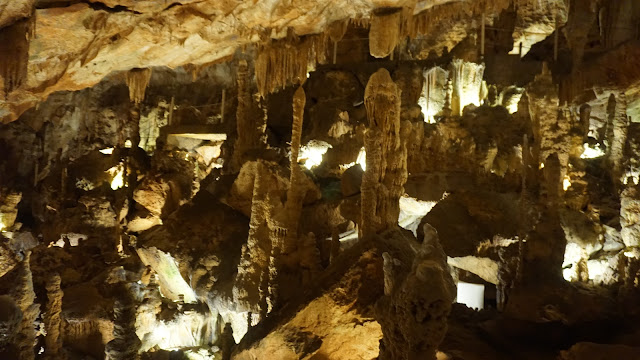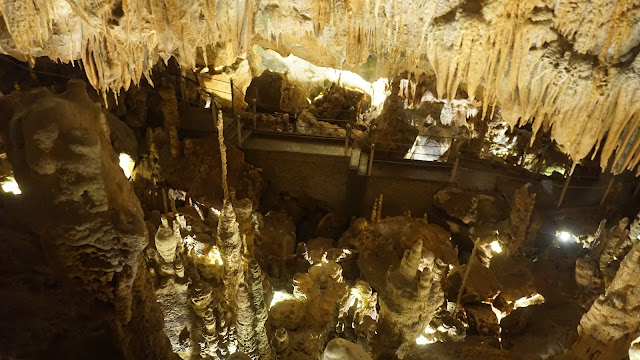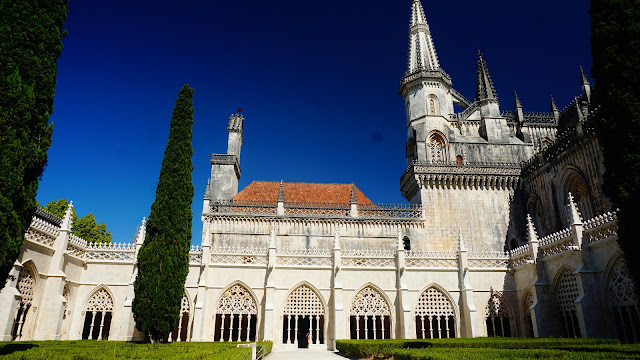We are still subject to jetlag, but everyone woke up around 7am, but we chose to be lazy about heading out of the house, so with breakfast (bread, cheese, sausage, sardines, veggies), and getting ready, we were out of the house by about 10.
First destination is a repeat for us: Grutas da Moeda , a.k.a., the Coin Caves, which we visited on our Day 4 last year. The caves are located just outside Fatima, on the opposite side of the A1 highway. We took a fairly scenic route there - driving mostly surface streets and the N- roads that went through a string of small villages in the Ourem/Fatima area.
We got to the caves just in time - the place was close to empty (two families ahead of us when we were buying tickets) - about 30 mins later, when we got out of the caves, we saw two busloads of tourists go in - creating a bit of congestion. Grutas da Moeda offer a self-guided tour, sending a group down into the caves every 2 mins or so. We were really impressed last year and the tour was goo d today as well. Since we went to three different caves today, some comparisons are in order, so, here is a brief description of the nature of these.
Grutas da Moeda. The caves offer a self-guided walk through. The cave system itself is pretty narrow - there are no great rooms or large ceilings, except for one place where the cave drops down several meters. Instead, we are treated to viewing small spaces filled with cave formations (columns, stalactites, stalagmites, curtains, etc...) There is a lot of water in the cave - both in a form of streams, as well as in the form of small lakes an ponds. There is a place where the water is so still that it creates the illusion that it is gone from the pond, leaving only the coins at the bottom. Olga thought that pond was dry last year. Surprisingly, she totally thought it this year again, and had to touch the water (creating quite a splash, as she thought she was going for the dry bottom).
Most of the walk is through a narrow pathway cut in the rock, open to the small chambers of the cave. The walk is about 20-25 minutes if one spends reasonable but not exuberant time taking pictures down there.
The walk comes out at the back of the Grutas da Moeda property, about 50 meters away from the entrance to the caves. Upon completing the walk, the property also offers a tasting of Grutas da Moeda branded alcoholic drinks (sweet red wine, sweet white wine, honey liquor, ginjinha) and some sweet bread. They have a large rocks and crystals store and a souvenir shop/cafe, with coffee, ice cream and some shakes.
Upon completing the tour we did some shopping, tasted the wines (I still have a bottle at home from my last visit), had coffee (I had ice cream), and then headed for our second location, Grutas de Santo Antonio.
Last year, we visited Grutas de Mira d'Aire, located in Mira D'Aire - a small textile town spread along the eastern side of a narrow valley, about 20 minutes away from Fatima. This time we went to the western ridge framing the same valley, to a small village of Alvados, above which there are two caves. Our first destination, Grutas de Santo Antonio is located higher on the ridge. Our second destination, Grutas de Alvados is located 1.5 km away, and a bit lower. We passed the latter on the way to the former, thinking that we would just visit one cave, but these guys are smart - they had a discounted price for visiting both caves, so we figures, we'd do that - as it would give Olga and I complete coverage of the caves (open for tourist visits) in the immediate vicinity of Fatima and Batalha. So....
Grutas de Santo Antonio. San Antonio Caves is the smallest of the three cave systems we visited today. It consists of two chambers - the small one, at the tour entrance, and the large one, connected by a relatively short walkway cut in the rock. The tour leaves about once every 30 mins. Our tour group consisted of ourselves and a Portuguese couple. Our tour guide, a young woman spoke to them in Portuguese and then repeated her words in English. The tour itself is around 30 mins, and compared to Grutas da Moeda - this place is quite deserted - during our time there only one more family (from France) came - they went on a separate French-language tour after us.
Grutas de Santo Antonio: a lake at the entrance to the caves.
The main attraction of the tour though is quite fabulous. The big chamber is big and features a lot of beautiful formations. The walk goes right through the chamber, with a pathway going up and down in a loop around the formations. The cave floor is a mess of large boulders, with some of the formations growing directly on the boulders.
There are plenty of totally stunning formations around, and in general, the cave is well worth the visit, especially, since it is not very busy, and with very few people on the tour - it opens quite a few possibilities for photography.
One thing we got to see only in the San Antonio caves were bats. Our tour guide apparently spotted them on earlier tours, and showed us both. One was pretty close to the entrance and easy to take a picture of. The other one was hanging from the ceiling of the main chamber, pretty high up, so no close-up pictures were possible. (but it was a first for us nevertheless - we visited something like 10 caves around the world, and this was the first time we saw bats in the cave).
After Grutas de Santo Antonio, we went directly to the car, wanting to catch the tour in the Grutas de Alvados before the turn of the hour (it was close to 2pm). We took a short stop at a vista point on the road connecting the caves - it runs along the ridge and gives great views of the valley and the town of Mira D'Aire on the opposite ridge.
Grutas de Alvados. The least visited by tourists (we got a private tour, and there were no other visitors during our stay there), this cave system holds its own easily. Per our guide, the original system existed as two separate caves - the smaller cave was known to local shepherds for a very long time as a place to rest or take flock into during heavy rains. The larger cave was discovered only recently when someone saw a natural opening, and went through. To create the tourist attraction, they connected the two caves with a passage carved in the rock. The tour starts at the entrance to the smaller cave (the original natural opening somewhat reinforced and widened), proceeds through the small and then the large cave and ends in the small building where the ticket office and the cafe are located (the building backs up directly into the rock formation).
Grutas de Alvados.
The large cave is the most spread out and the most voluminous of the one ones we saw today.
There are several places where it drops anywhere between 10 and 70 meters down. The walkway in many places has open ceiling rather than the standard 2 meter-high ceiling in most other caves we visited. There are plenty of formations, and the guided tour is a bit more informative than in the San Antonio caves (although still far from the intensity of the Mira D'Aire caves tour).
This cave has the brightest lighting of the three caves we visited allowing for much brighter pictures - although sometimes the lighting does wash away the intricacy of the formations around. The formations are plentiful and beautiful.
Overall. While we never did this (splitting our cave visits last year, and doing only three out of the four caves this year), going to all four caves in the area is an easy day trip for anyone staying within 30 mins drive from Fatima. It is totally worth visiting each of the four caves (Mira D'Aire is the biggest one, with more visitors and a very well-structured tour, but it also takes the longest time to visit), as each cave is quite different from the others. Grutas de Moeda offers a very intimate experience with both the self-guided tour, and with the spaces we get to visit. Mira D'Aire showcased the grandeur of a cave system really well. San Antonio has the huge and stunning main chamber that alone is worth the drive. Alvados has the unique ceiling heights, and sheer drops, and looks and feels quite different from the other three.
Grutas de Alvados: a lake at the end of the cave.
Moving on. We were done at the Grutas de Alvados around 3pm. From there we went to Batalha, which is also a repeat for Olga an I. On our way we almost ran out of gas, so stopped for a quick refill in Porto de Mos, which features an interesting looking castle (Yuri commented that it looked like a castle from the Russian retelling of the Wizard of Oz story). But with us being somewhat short on time (Batalha closes at 5:30), we moved on without visiting.
Batalha. We arrived around 3:35, found a café on the square overlooking the monastery and grabbed a quick lunch. Olga and I had our first bifanas of the trip. These got served dry, with piri piri and mustard on the side. The bifanas were good - the meat was well marinated and seasoned and tasty. We also decided that my homemade bifanas also rise to the occasion.
After lunch we proceeded to the monastery, bought tickets and toured it just like we did last year. This time is was mostly for Tatiana's and Yuri's benefit. I did not take as many pictures, and we spent about half the time in the monastery as Olga and I spent last year (to be fair, some areas were under renovation and we could not go there). As before, the Unfinished Chapels were the highlight. Outside the monastery a group of Spanish World Youth Day pilgrims was doing a motivational song an dance. Inside the main church a group of Polish attendees were engaged in a Polish language service/sermon. Later, the same group, guitars and ukuleles out, walkoed around the perimeter of the monastery singing hymns and performing some other services after the end of each song.
We reserved a table (as it turned out - needlessly, as they had plenty of space) at Burro Velho (old donkey) for 7:15pm, and after completing the monastery tour had close to two hours before the reservations. I visited the Burro Velho's wine store, which I remember from the last trip (the difference is that I don't think I bought any wine there last time) and bought two bottles of cheap white wine, one bottle of Portuguese bubbly (which Olga and Tatiana opened in the evening and hated), and a bottle of dry white port which I will open when we come back to Lisbon.
After that, there was some souvenir shopping. Batalha's souvenir stores have some textiles - things that are not found in other places, and a few additional (not necessarily purely souvenir) stores that attracted our attention last year. So, basically, a decent location to buy presents to bring back home.
After 7 we went to the restaurant, sat outside and ordered food and drinks.
We went through two liters of white sangria (fizzy, with apple, orange and lemon as the fruit), ordered bread, olives, fresh cheese and chicken gizzards (!) for appetizer. I did not try the gizzards, but the sauce was good. Olga said the gizzards themselves were a bit on the saltier side, but at this point it seems more of a general rule of Portuguese cuisine than individual chef's faux pa.
Olga and I had octopus as the main dish, served with potatoes and what I can only describe as the Portuguese version of stuffing; a slightly cooked mix of bread, greens, and legumes. The portions were generous - two huge tentacles per dish. The restaurant was on the pricier side, although we avoided their priciest dishes (freshly grilled fish sold by Kg), still got a high by local standards bill. We'll see if we ever get to exceed it in Lisbon (perhaps if we ever get to the end of the dinner and want deserts?)
The octopus.
After dinner, went to the car, drove home - a 35 minute trip. Came back just after 9pm, called it a night.
Steps. I was at less than 6,000 when we came to Batalha, but ended up with something like 12,580 on the watch (the phone thinks it was 9,740 - a bit of a discrepancy). Walking around Batalha turns out to rack up the steps.
Alcohol. The Burro Velho white sangria was refreshing. It had a bit less cinnamony aftertaste (and lacked cinnamon), but I still like the riverfront sangria from Day 1 the best. (We also had white sangria at lunch. It was flat and not as good as the other sangrias we tried. The fizziness is the key here).
The highlight of the tasting at Grutas da Moeda was the ginja, but they only sold a 15-euro bottle w/o fruit, and I wasn't interested in either buying it for drinking here, nor in taking it home with me.
U-pick. The red grapes around the fence surrounding the property are ripe and tasty.
Next: Leaving this place, going to Obidos and Peniche tomorrow, with a two-night stay in Ribamar, just south of Peniche.


























No comments:
Post a Comment